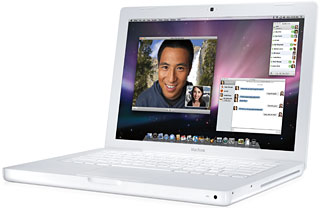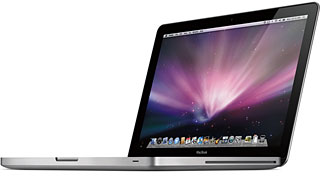I've been trying to decide whether the timing of my column last week on Apple's low-end
2.1 GHz $999 MacBook
White was impeccably bad or inadvertently appropriate in drawing
attention to that heretofore somewhat ignored model the day that Apple
unexpectedly released a substantial upgrade of the product.

The MacBook White.
If you read that column, you'll perhaps recall that I concluded my
commentary deducing that Apple would not want to continue the
manufacturing, parts sourcing, and inventory complication of building
two completely distinct families of MacBook indefinitely, and that that
the polycarbonate model would likely be replaced by an entry-level
unibody machine.
Changes to the MacBook White
Au contraire, as it turned out. Last Tuesday, Apple quietly
rolled out an impressively
enhanced update of its price leader MacBook, replacing the poky old
Intel GMA X3100 integrated graphics chipset with the same (claimed to
be up to 5x faster) Nvidia GeForce 9400M graphics used in the Unibody MacBooks and the
MacBook Air.
The entry-level MacBook also got slightly downclocked from its
erstwhile 2.1 GHz to the same 2.0 GHz Penryn Core 2 Duo CPU with
3 MB on-chip shared L2 cache used in the base Unibody. The MacBook
White also gets a faster 1066 MHz frontside bus (up from 800 MHz in the
preceding model) plus 2 GB RAM standard instead of the former 1 GB, all
for the same US$999 price - and it still has a FireWire 400 port, which
is huge for some of us. Unchanged are the standard 120 GB 5400 rpm SATA
hard drive (upgradable to 320 GB) and dual-layer 8x SuperDrive.
Well, perhaps my surmise was not entirely off-base. Using the same
CPU and graphics chipset in both the plastic and aluminum MacBooks
should result in some economies of scale, and parts-sourcing/inventory
rationalization for Apple, as well as goosing sales.
One way to look at it is that in order to come up with something to
address the market share challenge posed by small, cheap PC laptops
(so-called netbooks), Apple has decided, at least as a first response,
to stick with its entry-level price point but add value - a substantial
amount of value - by upgrading the polycarbonate MacBook with some
solid specification enhancements, arguably creating the most value for
dollar spent that Apple has ever offered in a notebook.
Looking Ahead
My initial thought after hearing the news was "I want one,"
reasoning that my biggest objection to the superseded version had been
its lazy graphics support - not that I'm a gamer or into a lot of video
or high-end graphics work, but I'm inclined to keep my computers for a
long time. With Mac OS X 10.6 "Snow Leopard" coming, reportedly
optimized to utilize graphics processors more extensively than previous
OS X versions, that is something to consider. The new Nvidia
GeForce 9400M graphics should handle Snow Leopard more than adequately,
the standard 2 GB of RAM is serious added value, as is the faster
frontside bus - and it's the last Apple laptop with a FireWire 400
port.
The "downgrade" in processor clock speed by 100 MHz (5%) and
retention of 667 MHz DDR2 memory instead of the faster 1066 MHz DDR3
used in the unibody models should be relatively inconsequential
performance-wise, given the faster graphics and bus, so the update is
basically all good with nothing important lost and a lot gained.
 And yet, oddly enough, focusing on the
specification enhancements for the new low-end model, I've found myself
even more inclined more toward buying a base unibody machine as my next
computer, even though the value of the new white model is very tough to
beat.
And yet, oddly enough, focusing on the
specification enhancements for the new low-end model, I've found myself
even more inclined more toward buying a base unibody machine as my next
computer, even though the value of the new white model is very tough to
beat.
Polycarbonate or Aluminum?
There is no denying the seductiveness and solidity of the unibody
enclosure compared with the styling and robustness of the polycarbonate
enclosure, which essentially dates back to the first dual USB iBooks of
2001. I like the whitebook's look well enough, but having bought a 12"
iBook back at the end of 2002, it's more than a bit "been there, done
that" for me - and as someone commented last week, "The white one is a
better buy, but the aluminum is gorgeous."
Then there are the screen backlights: the white model still uses a
traditional CCFL tube rather than the Unibody's state-of-the-art LED
backlighting - not in itself a deal-breaker, but anther factor to
consider.
On the other hand, I prefer the conventional trackpad with a
separate button on the old school model to the glass one in the Unibody
with its integrated click function, which is just a bit too needlessly
gimmicky for my taste. However, since I use an external mouse most of
the time anyway, that's not a really critical issue for me either.
Neither is the matter of Mini DVI vs. Mini DisplayPort, as I don't
usually use external monitors with my laptops and could not justify the
cost of the DisplayPort-only 24" Cinema Display in any case.
The 40 GB greater standard hard drive capacity in the Unibody would
provide a comfortable amount of headroom, but I'm still getting along
with an 80 GB unit on my current PowerBook, so 120 GB should be plenty
for me at this time - and they're so easily upgraded in these
machines.
FireWire support is more important - or is it? I do have one
external hard drive that is FireWire-only, but my 1G FireWire-only iPod
died some time ago. Both my flatbed and slide scanners are FireWire/USB
ambidextrous, and while I really like FireWire Target Disk Mode, I
don't use it often enough to say I couldn't work around not having it.
Bootability is probably the most compelling FireWire consideration for
me. I'm told that Intel Macs will boot happily from USB drives, but I'm
wondering if that really includes support so solid and dependable that
you can use a USB drive as a substitute boot drive as I did for several
days recently while troubleshooting an issue with my main boot system
on my PowerBook.
As for other distinctions, being slightly smaller and thinner in
form factor and half a pound lighter in weight definitely cuts in favor
of the Unibody, making it closer to being a true replacement for the
old 12" PowerBook as a serious road warrioring machine, and 30 minutes
more rated battery life could prove useful as well. Another intangible
is that the Unibody represents the future, as opposed to the
whiteBook's mature and thoroughly-developed past.
The price of the white unit is certainly attractive. I live in
Canada, and Apple Canada wants Can$1,149 for the white model (which at
the current exchange rate makes it cheaper in Canada than the US), but
will sell you an Apple Certified Refurbished 2.0 GHz Unibody for just
$50 more than that, and even the full price of Can$1,399 is a very
decent deal as well, being only Can$250 more than the white model as
opposed to the $300 difference at the US Apple Store.
I'm still on the fence, but definitely leaning toward the Unibody.


 And yet, oddly enough, focusing on the
specification enhancements for the new low-end model, I've found myself
even more inclined more toward buying a base unibody machine as my next
computer, even though the value of the new white model is very tough to
beat.
And yet, oddly enough, focusing on the
specification enhancements for the new low-end model, I've found myself
even more inclined more toward buying a base unibody machine as my next
computer, even though the value of the new white model is very tough to
beat.
